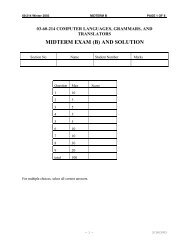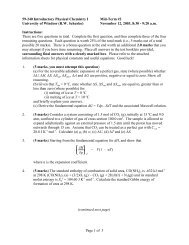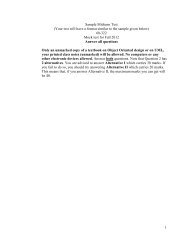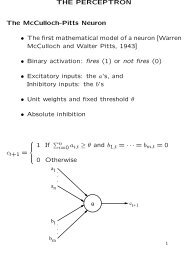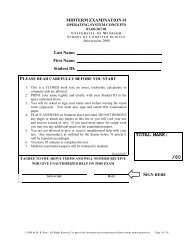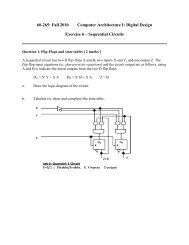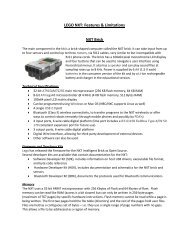Create successful ePaper yourself
Turn your PDF publications into a flip-book with our unique Google optimized e-Paper software.
(e) Which of the following would you expect to have the smallest covalent radius:oxygen, fluorine, sulphur or chlorine? Why? (Briefly)(f) Aluminum and gallium have the approximately the same radius in their covalentcompounds. Based on your answer to part (e), you might not have predicted thisobservation. What extra factor(s) help to explain this similarity.Question #4 [30](a) There are two different types of valence MO diagrams for the homonuclear diatomicmolecules of the second period (Li 2 to Ne 2 ). Draw fully labeled diagrams for these twocases and indicate which of the diatomic molecules of the second period are described byeach diagram.(b) Why are the MO's for the diatomic molecules of the second row ordered in these twodifferent ways?(c) What bond orders are predicted using the diagrams in part (a) for the ions N 2 +1 , N 2 -2 .(Hint, the results should be identical for either type of diagram.)(d) Describe how the diagrams from part (a) should be modified to show the MO energylevels of NO + , a heteronuclear diatomic ion? (Briefly.)(e) Draw a Lewis structure for O 2 and using the appropriate molecular orbital energylevel diagram drawn above in part (a) determine the following: on which feature(s) of thedioxygen molecule do the two bonding models agree and on which do they differ. Whichmodel agrees most closely with the experimental observations.Question #5 [25](a) Use an appropriate Born-Haber cycle to estimate the total electron attachmententhalpy for the formation of O -2 (g) from O (g) using the following data (all in kJ/mol):Mg(s) → Mg(g) ∆H° vap = 147O 2 (g) → 2 O(g) ∆H° d = 497Mg(g) → Mg + (g) ∆H° ie = 737Mg + (g) → Mg +2 (g) ∆H° ie = 1450∆H° F (MgO) = -602U 0 (MgO) = -3950(b) Use the Born-Mayer equation to estimate the lattice energy for Mg 2 O using thefollowing data: the radius in Å for Mg is 1.60, the radius for Mg + is 1.16, the radius forMg +2 is 0.72 and the radius for O -2 is 1.40. The Madelung constant for a rock saltstructure is 1.748, the Madelung constant for a fluorite structure is 2.519.






